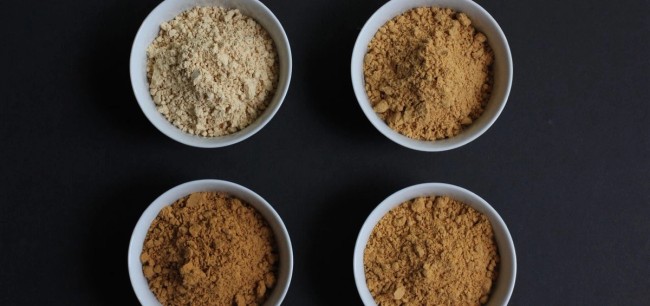The protein we eat helps build muscle (1). If you want a protein that also delivers nutrients that support overall health, look no further than peanut powder, the naturally gluten free, defatted flour made from peanuts. Peanut powders contain only peanuts – no fillers or other ingredients that you don’t need.
Peanut Packed Nutrition
Like pinto beans, kidney beans, white beans and chickpeas, peanuts are legumes, a versatile, high fiber food that also contains protein. Every 1/4 cup (15 grams) of peanut powder (also referred to as peanut protein or peanut flour) contains 50 calories, 8 grams of protein and is an excellent source of niacin and manganese providing 20% or more of the Daily Value (DV) for these nutrients. Peanut powder is a good source of phosphorus, folate, copper and magnesium providing at least 10% of the DV for these nutrients and making it a nutrition-packed option (2).

Peanut flours aka peanut powder. Image: Lori Rice of Fake Food Free
Peanut powder contains approximately 1/2 gram of leucine per serving. Leucine is an amino acid that turns on muscle building and repair, which is essential whether you are an athlete or an older adult. Adults need approximately 2 to 3 grams of leucine per meal to maximally stimulate the synthesis of new proteins in muscle while older adults may need more, approximately 3 to 4 grams of leucine per serving (3, 4). Peanut powder makes meeting your leucine needs easy. Here are some ideas for after training and mealtime:
- 2 servings (30 grams; just over 1 oz.) of peanut powder mixed into 10 oz. of milk (2 grams of leucine)
- 2 servings (30 grams) of peanut powder mixed into 7 oz. of low-fat plain Greek yogurt (2.06 grams of leucine)
- 2 servings of peanut powder mixed into a soup or stew containing 1/3 cup (or more) chopped chicken (2.08 grams of leucine)
Peanut powder can also be used to replace portions of flour in baked goods to increase the nutritional content in regular or gluten-free baking. Start by replacing up to 1/3 of the amount of regular flour with peanut flour and mix it with the other flours you are using before mixing it with the rest of the recipe.
What About Anti-Nutrients?
Anti-nutrients are compounds found in food that decrease the absorption of vitamins, minerals or amino acids (5). Some people, for example those who follow the Paleo diet, think they should avoid foods that contain these so-called anti-nutrients. However, the term “anti-nutrient” is misleading because many of these compounds have beneficial effects in the body (6). An emerging in vitro research study titled “Functional Properties of Peanut Fractions on the Growth of Probiotics and Foodborne Bacterial Pathogens” published in the Journal of Food Science, examined the relationship between various compounds found in peanuts and peanut flour, including lectins, and the growth of beneficial bacteria in the gut. This bacteria improves gut health, supports immune health and helps the body fight off harmful bacteria (7, 8).
Don’t let the indulgent thick texture and rich taste of peanut powder fool you. It is a calorie-conscious way to get more nutrition into your diet. Protein supports muscle growth and repair (2). Peanut powder is an excellent source of protein and contains valuable nutrients. It can be used post-workout and at mealtime.
Marie Spano, MS, RD, CSCS, CSSD, has helped elite, professional and amateur athletes go beyond their personal best and achieve maximum performance in their respective sport. Marie is also an accomplished researcher with regular contributions to popular media such as Muscle & Fitness Hers and FitnessRx for Women, as well as industry publications. She is the co-editor of a forthcoming Human Kinetics textbook on Sports Nutrition.
- Trumbo, P., Schlicker, S., Yates, A. A., Poos, M., & Food and Nutrition Board of the Institute of Medicine, The National Academies (2002). Dietary reference intakes for energy, carbohydrate, fiber, fat, fatty acids, cholesterol, protein and amino acids. Journal of the American Dietetic Association, 102(11), 1621–1630. https://doi.org/10.1016/s0002-8223(02)90346-9
- US Department of Agriculture, Agricultural Research Service. FoodData Central. Version Current: 2019. Internet: https://fdc.nal.usda.gov/
- Joy, J. M., Lowery, R. P., Wilson, J. M., Purpura, M., De Souza, E. O., Wilson, S. M., Kalman, D. S., Dudeck, J. E., & Jäger, R. (2013). The effects of 8 weeks of whey or rice protein supplementation on body composition and exercise performance. Nutrition journal, 12, 86. https://doi.org/10.1186/1475-2891-12-86
- Katsanos, C. S., Kobayashi, H., Sheffield-Moore, M., Aarsland, A., & Wolfe, R. R. (2006). A high proportion of leucine is required for optimal stimulation of the rate of muscle protein synthesis by essential amino acids in the elderly. American journal of physiology. Endocrinology and metabolism, 291(2), E381–E387. https://doi.org/10.1152/ajpendo.00488.2005
- Kannan, S., Nielsen, S. S., & Mason, A. C. (2001). Protein digestibility-corrected amino acid scores for bean and bean-rice infant weaning food products. Journal of agricultural and food chemistry, 49(10), 5070–5074. https://doi.org/10.1021/jf010323u
- Martínez-Villaluenga, C., Frias, J., & Vidal-Valverde, C. (2008). Alpha-galactosides: antinutritional factors or functional ingredients?. Critical reviews in food science and nutrition, 48(4), 301–316. https://doi.org/10.1080/10408390701326243
- Peng, M., Bitsko, E., & Biswas, D. (2015). Functional properties of peanut fractions on the growth of probiotics and foodborne bacterial pathogens. Journal of food science, 80(3), M635–M641. https://doi.org/10.1111/1750-3841.12785.
- Pusztai A. (1993). Dietary lectins are metabolic signals for the gut and modulate immune and hormone functions. European journal of clinical nutrition, 47(10), 691–699.
